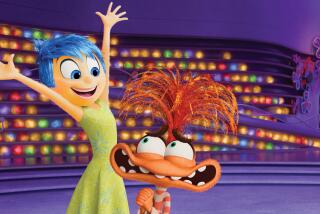Review: Out of this world: Pixar’s ‘Wall-E’ is sweetly wonderful and full of wonder
IF Pixar Animation Studios has an enviable record of consistent success -- and with a worldwide box-office gross of $4.3 billion from its eight films, it certainly does -- it’s because the company has an uncanny gift for pushing things further without pushing too far. Pixar’s adventurous new film, the one-of-a-kind “Wall-E,” shows how it’s done.
Daring and traditional, groundbreaking and familiar, apocalyptic and sentimental, “Wall-E” gains strength from embracing contradictions that would destroy other films. Directed by Pixar stalwart Andrew Stanton, who co-wrote and directed the Oscar-winning “Finding Nemo,” “Wall-E” is the latest Pixar film to manage what’s become next door to impossible for anyone else: appealing to the broadest possible audience without insulting anyone’s intelligence.
Part robot romance between two mismatched mechanized marvels, part science fiction saga with deliberate echoes of Stanley Kubrick’s “2001,” this may be the first animated feature to pivot around novelist E.M. Forster’s famous imperative, “Only connect.”
The origins of “Wall-E’s” story, as related in the film’s teaser trailer, go back to 1994, when Pixar honchos held a now-celebrated lunch to spitball story ideas, which became “A Bug’s Life,” “Monsters, Inc.” and “Finding Nemo.” “Wall-E” is the last of that group to get made, in part because elements of it are so unconventional.
For one thing, the film’s exceptional first half hour or so lives and breathes on screen with just about zero human dialogue. But with the storied Ben Burtt, who did the job on “Star Wars,” creating all kinds of noise as the film’s sound and character voice designer, as well as music by Thomas Newman, you won’t miss those words at all.
You also won’t miss them because the world of “Wall-E,” created by production designer Ralph Eggleston and his team, with the advice of high-powered cinematography consultants Roger Deakins and Dennis Murren, is so remarkable. The time is 800 years in the future and the setting is our own Earth, but it’s not an Earth anyone would want to recognize.
Not to put too fine a point on it, our planet is a disaster, a bleak and disheartening ruin where every available surface is covered by towering skyscrapers of trash. It got so bad that Buy n’ Large, the conglomerate that has somehow taken charge of the planet, leaned on the entire human population to leave with a “space is the final fun-tier” campaign that featured slogans such as, “Too much garbage in your face? There’s plenty of space out in space.”
Though not likely the main reason the film was made, “Wall-E” can’t help but send out a powerful and even frightening environmental message. Though G-rated, its dystopian vision (shot by Jeremy Lasky and Danielle Feinberg) of what the perils of consumer excess have in store for the planet is unnerving without trying too hard, bringing to mind the old truism that Walt Disney and his company (Pixar’s parent) have scared more people than Alfred Hitchcock.
One reason “Wall-E” is as audience-friendly as it finally is is the presence of the endearing title character, whose name is an acronym for Waste Allocation Load Lifter -- Earth Class. What that means in practical terms is that Wall-E is a robotic trash compactor who has been quietly doing his job attacking Earth’s endless mountains of refuse for 700 years. Unless you count his pal, a nameless but convivial roach, Wall-E is the only thing still moving on the entire planet.
Given all that, it’s to be expected that Wall-E, whose large binocular eyes and narrow neck turn him into a squat, mechanical E.T., has developed a few personal eccentricities over the years. For one thing, he’s quite the collector, squirreling away everything from old Rubrik’s Cubes to light bulbs to an actual living plant.
More than that, this set-in-his-ways old bachelor robot has developed a fixation with the movies. Not really the movies, but one movie in particular, the only video he’s got. It is, of all things, “Hello, Dolly!” and screenwriters Stanton and Jim Reardon had the shrewd idea of opening the film with the jaunty lyric, “Out there is a world outside of Yonkers,” as the camera somberly pans both the universe and the ruins of Earth.
What really entrances “Wall-E” about “Hello, Dolly!” is the spectacle of people expressing emotion and connection by holding hands. Not a word is spoken, but we understand that this lonely Robinson Crusoe, like so many movie creatures before him, would like nothing better than to hold hands with another entity. And then it happens.
A spaceship lands in Wall-E’s neighborhood and leaves behind a sleek white oval-shaped probe-droid with bewitching blue eyes named Eve (for Extra-terrestrial Vegetation Evaluator), sent to Earth to find signs of life. High tech and armed with a laser weapon that pulverizes anything in sight, Eve fascinates Wall-E and he nervously scuttles around after her, fearful but intoxicated by her every move.
Though this wordless section of the film, punctuated only by Wall-E’s frequent and idiosyncratic croak of “Eve,” is in some ways merely a set up for the second half, it is easily the most memorable and distinctive part of the film. This segment, a kind of song without words, is a world-creating work of pure imagination that has been thought out to the nth degree.
“Wall-E’s” second half involves the dauntingly overweight humans who have sent the probe (and who are shrewdly not pictured in any publicity material.) They’ve lived for centuries on a cruise liner-type spaceship called the Axiom run by a barely functional captain ( Jeff Garlin) in thrall to a Hal-type eminence called Auto, voiced, in a nod to “Alien,” by Sigourney Weaver.
This part of the story gets increasingly familiar and sometimes borders on the predictably sentimental. But along with these inevitable elements of calculation, “Wall-E” never loses its sense of wonder: wonder at life, wonder at the universe, and even wonder at the power of computer animation to create worlds unlike any we’ve seen before. How often do we get to say that in these dispiriting times?
“Wall-E.” MPAA rating: G. Running time: 1 hour, 37 minutes. In general release.
More to Read
Only good movies
Get the Indie Focus newsletter, Mark Olsen's weekly guide to the world of cinema.
You may occasionally receive promotional content from the Los Angeles Times.










